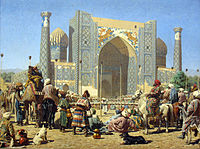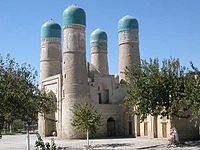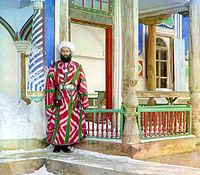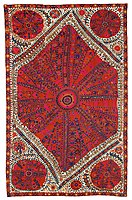Emirate of Bukhara
Emirate of Bukhara امارت بخارا ( Chagatay ) | |||||||||
|---|---|---|---|---|---|---|---|---|---|
| 1785–1920 | |||||||||
|
Flag | |||||||||
 The Emirate of Bukhara under Russian rule c. 1900 | |||||||||
| Status |
| ||||||||
| Capital and largest city | Bukhara | ||||||||
| Common languages | |||||||||
| Religion | Sunni Islam, Shia Islam, Sufism (Naqshbandi), Zoroastrianism, Judaism | ||||||||
| Government | Absolute monarchy | ||||||||
| Emir | |||||||||
• 1785–1799 | Mir Masum Shah Murad | ||||||||
• 1911–1920 | Mir Muhammad Alim Khan | ||||||||
| History | |||||||||
• Manghit control | 1747 | ||||||||
• Shah Murad became Emir | 1785 | ||||||||
• Conquered by Russia | 1868 | ||||||||
• Russian protectorate | 1873 | ||||||||
| 2 September 1920 | |||||||||
| Population | |||||||||
• 1875[4] | c. 2,478,000 | ||||||||
• 1911[5] | c. 3,000,000–3,500,000 | ||||||||
| Currency | fulus, tilla, and tenga.[6] | ||||||||
| |||||||||
The Emirate of Bukhara (
History
The Emirate of Bukhara was officially created in 1785, upon the assumption of rulership by the
As one of the few states in Central Asia after the Mongol Empire not ruled by descendants of Genghis Khan (besides the
Over the course of the 18th century, the emirs had slowly gained effective control of the
In 1868, the emirate lost a
Reformists within the Emirate had found the conservative emir,
Culture
In the era of the Manghyt emirs in Bukhara, a large construction of madrasahs, mosques and palaces was carried out. Located along important trading routes, Bukhara enjoyed a rich cultural mixture, including
influences.A local school of historians developed in the Bukhara emirate. The most famous historians were Mirza Shams Bukhari, Muhammad Yakub ibn Daniyalbiy, Muhammad Mir Olim Bukhari, Ahmad Donish, Mirza Abdalazim Sami, Mirza Salimbek.[18]
The city of Bukhara has a rich history of Persian
-
The Emir of Bukhara and the notables of the city watch how the heads of Russian soldiers are impaled on poles. Samarkand
-
Chor Minor Madrasah, Bukhara (built in 1807)
-
A bureaucrat in Bukhara, ca.1910.
-
Large Medallion Suzani (textile) from Bukhara, mid-18th century?
Administrative and territorial structure


Administratively, the Emirate was divided into several beyliks or bekliks:
- Baljuvon, (now Khatlon Region, Tajikistan).
- Hisar, (now Tajikistan)
- Burdalik, (now Lebap Region, Turkmenistan)
- Guzar, (now Qashqadaryo Region, Uzbekistan)
- Charjuy, (now Lebap Region, Turkmenistan)
- Darvaz, (c 1878, now Darvaz district, Tajikistan)
- Dehnav, (now Surxondaryo Region, Uzbekistan)
- Kabakli, (now Lebap Region, Turkmenistan)
- Karakul, (now Bukhara Region, Uzbekistan)
- Rasht district, Tajikistan)
- Karshi, (now Qashqadaryo Region, Uzbekistan)
- Kattakurgan, (now Samarkand region, Uzbekistan)
- Kulyab, (now Khatlon Region, Tajikistan)
- Karshi, (now Qashqadaryo Region, Uzbekistan)
- Kerki, (now Lebap Region, Turkmenistan)
- Nurata, (now Navoiy Region, Uzbekistan)
- Sughd province, Tajikistan)
- Gorno-Badakhshan Autonomous region, Tajikistan)
- Samarkand, (now Samarqand Region, Uzbekistan — part of Russia since 1868
- Kashkadarya Region, Uzbekistan)
- Urgut, (now Samarqand Region, Uzbekistan)
- Falgar, (now Sughd province, Tajikistan)
Amirs/Emirs of Bukhara (1785–1920)
| Titular Name | Personal Name | Reign |
|---|---|---|
| Ataliq اتالیق |
Khudayar Bey خدایار بیگ |
? |
| Ataliq اتالیق |
Muhammad Hakim محمد حکیم |
?–1747 |
| Ataliq اتالیق |
Muhammad Rahim محمد رحیم |
1747–1753 |
| Amir امیر |
Muhammad Rahim محمد رحیم |
1753–1756 |
| Khan خان |
Muhammad Rahim محمد رحیم |
1756–1758 |
| Ataliq اتالیق |
Daniyal Biy دانیال بیگ |
1758–1785 |
| Amir Masum امیر معصوم |
Shahmurad شاہ مراد بن دانیال بیگ |
1785–1799 |
| Amir امیر |
Haydar bin Shahmurad حیدر تورہ بن شاہ مراد |
1799–1826 |
| Amir امیر |
Mir Hussein bin Haydar حسین بن حیدر تورہ |
1826–1827 |
| Amir امیر |
Umar bin Haydar عمر بن حیدر تورہ |
1827 |
| Amir امیر |
Nasr-Allah bin Haydar Tora نصراللہ بن حیدر تورہ |
1827–1860 |
| Amir امیر |
Muzaffar bin Nasrullah مظفر الدین بن نصراللہ |
1860–1885 |
| Amir امیر |
Abdul-Ahad bin Muzaffar al-Din عبد الأحد بن مظفر الدین |
1885–1911 |
| Amir امیر |
Muhammad Alim Khan bin Abdul-Ahad محمد عالم خان بن عبد الأحد |
1911–1920 |
| Overthrow of Emirate of Bukhara by Bukharan People's Soviet Republic. | ||
- Pink Rows denote progenitor chiefs serving as Tutors (Ataliqs) & Viziers to the Khans of Bukhara.
- Green Rows denote chiefs who took over reign of government from the Janidsand placed puppet Khans.
- A photo of Mohammed Alim Khan, final emir 1911-1920, is shown at Emir.
See also
References
- ^ Roy (2000), The new Central Asia: the creation of nations, p.70
- ^ "About the national delimitation in Central Asia"
- ISBN 1-4020-1298-5.
- ^ |Meyendorf E.K. Travel from Orenburg to Bukhara. Foreword N. A. Halfin. Moscow, The main edition of the eastern literature of the publishing house "Science", 1975. (in Russian:Мейендорф Е. К. Путешествие из Оренбурга в Бухару. Предисл. Н. А. Халфина. М., Главная редакция восточной литературы издательства "Наука", 1975.)
- ^ Olufsen, Ole (1911). The emir of Bokhara and his country; journeys and studies in Bokhara. Gyldendal: Nordisk forlag. p. 282.
- ^ ANS Magazine. "The Coinage of the Mangit Dynasty of Bukhara" Archived 15 July 2020 at the Wayback Machine by Peter Donovan. Retrieved: 16 July 2017.
- ^ "نگاهی به امارت بخارا در صد سالگی انقلاب اکتبر". BBC News. 5 November 2017.
- ^ Golden, Peter B. (2011). Central Asia in World History. Oxford, UK: Oxford University Press. p. 115.
- ^ Soucek, Svat. A History of Inner Asia (2000), p. 180.
- ^ Bregel, Y. The new Uzbek states: Bukhara, Khiva and Khoqand: C. 1750–1886. In N. Di Cosmo, A. Frank, & P. Golden (Eds.), The Cambridge History of Inner Asia: The Chinggisid Age (pp. 392-411). Cambridge: Cambridge University Press 2009
- ^ Soucek (2000), pp. 179–180
- ^ Eastern Approaches ch 6 "Bokhara the Noble"
- ^ Soucek (2000), p. 198
- ^ Russo-Bukharan War 1868, Armed Conflict Events Database, OnWar.com
- ^ Becker, S. (2004). Russia's Protectorates in Central Asia: Bukhara and Khiva, 1865-1924. Storbritannien: Taylor & Francis., p. 67-68
- ^ Soucek (2000), pp. 221–222
- ISBN 978-90-04-10399-3.
- ^ Anke fon Kyugel'gen, Legitimizatsiya sredneaziatskoy dinastii mangitov v proizvedeniyakh ikh istorikov (XVIII-XIX vv.). Almaty: Dayk press, 2004
Bibliography
| History of Uzbekistan |
|---|
 |
|
|
| History of Turkmenistan |
|---|
 |
|
|
- ISBN 9780521657044.
Literature
- Malikov A., "The Russian conquest of the Bukharan Emirate: military and diplomatic aspects", Central Asian Survey, Volume 33, issue 2, 2014, p. 180-198.
External links
 Media related to Emirate of Bukhara at Wikimedia Commons
Media related to Emirate of Bukhara at Wikimedia Commons





